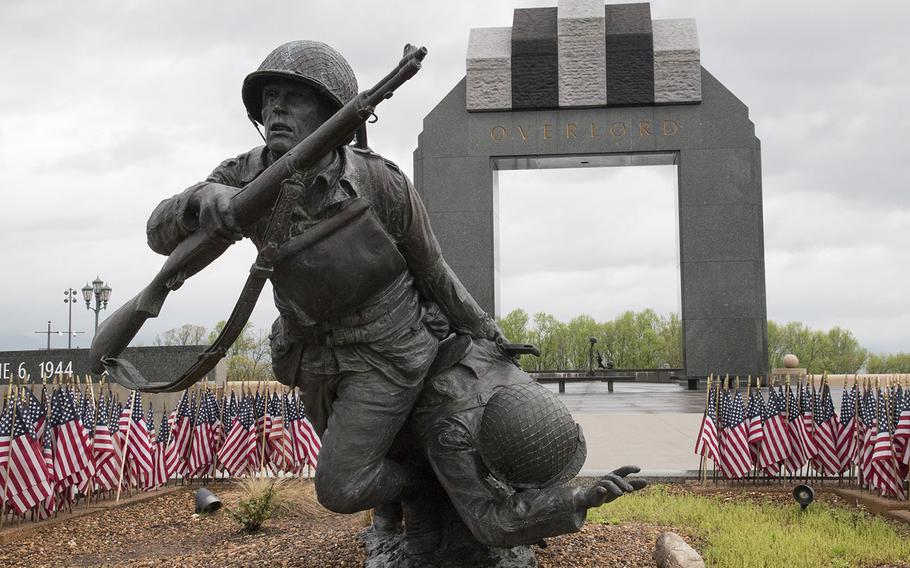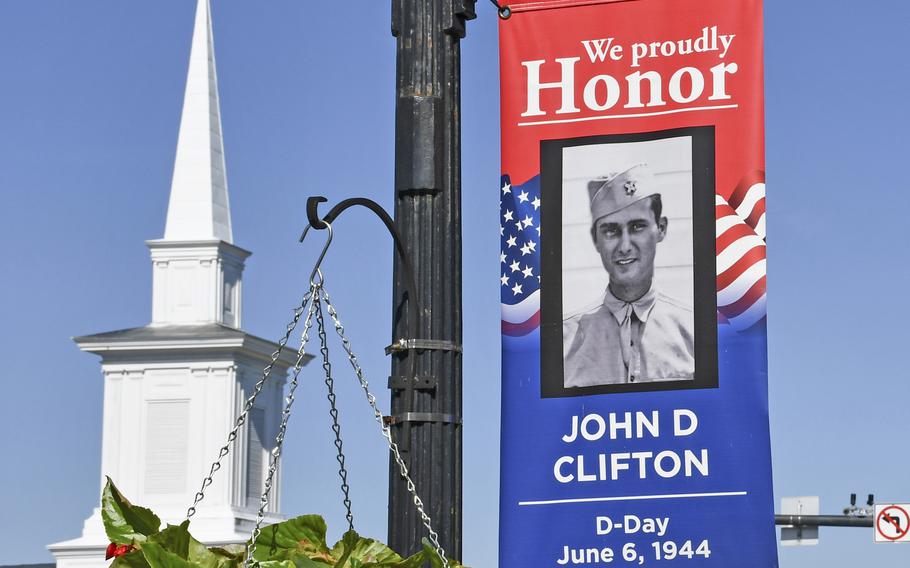
The National D-Day Memorial in Bedford, Va. During the Normandy invasion, Bedford — a town with about 3,200 residents — lost 23 soldiers, 19 of them on D-Day. (Joe Gromelski/Stars and Stripes)
Editor’s note: This story was originally published in 2019 to commemorate the 75th anniversary of the D-Day invasion. It has been republished ahead of this year’s 80th anniversary.
BEDFORD, Va. — Unlike many of the units that hit the shores of Normandy on D-Day, Company A of the 116th Infantry Regiment, 29th Division, was a National Guard outfit of men from the same hometown.
Thirty-seven had grown up together in Bedford, Va., graduated high school together, worked together — and 19 of them died together.
One woman in Bedford was hired by the state to write monthly reports about Bedford, describing the feelings of the townspeople, their working conditions and church attendance during World War II. The letters, signed “Mrs. George P. Parker,” are now kept at the Bedford Museum.
“Reports continue to come in of Bedford boys killed in combat or died of wounds,” Parker wrote Aug. 15, 1944. “People are brave, but tensely anxious. Bedford has been hard hit.”

Flags lining the downtown thoroughfare in Bedford, Va., on May 14, 2019, show photos of 19 soldiers from Bedford who were killed in action on D-Day. The town is home to the National D-Day Memorial. (Nikki Wentling/Stars and Stripes)
The per capita losses for Bedford on D-Day were among the highest in the country. In addition to the National D-Day Memorial established in Bedford in 2001, the significance of that history is apparent in the small community in other ways.
Half of the flags lining the downtown thoroughfare read, “Bedford Remembers,” and the other half show photos of the 19 soldiers — referred to reverently as the “Bedford Boys.”
Many of the older buildings in town are adorned with plaques denoting their connection to the Bedford Boys, including the old Green’s Drug Store, the former Bedford High School — now vacant — and two factories where several men had worked. Liberty Station is now a popular local restaurant, but it used to be a working train station where Company A departed for the war.
“It’s part of the town’s DNA,” said Jennifer Thomson, genealogical librarian at the Bedford Museum.
So, too, is military service, Thomson said.
German forces nearly obliterated Company A and its soldiers on June 6, 1944. With only a handful of more than 200 members fit for duty, the unit was disbanded after the war and remained dormant for 10 years.
“It was wiped out, decimated,” said Ken Parker, who’s writing a book of profiles about the Bedford Boys.

At the National D-Day Memorial in Bedford, Va., an Australian flag is placed next to plaques listing the names of soldiers from America's allies who were killed on June 6, 1944. (Joe Gromelski/Stars and Stripes)
But in 1954, it was reactivated by Lt. Elisha “Ray” Nance, who participated in the invasion of Normandy and returned to Bedford, where he worked as a mail carrier. Several other former members of Company A joined him in the reactivated unit.
Decades later, Company A is still headquartered in Bedford. In the early 2000s, the unit deployed to Afghanistan — the National D-Day Memorial serving as the site of the sendoff.
“There certainly is a legacy in the community of serving, a very proud legacy,” said Joe Banner, special projects manager for the National D-Day Memorial. “It’s really retained a lot of its military history and lineage, and I think that’s very special.”